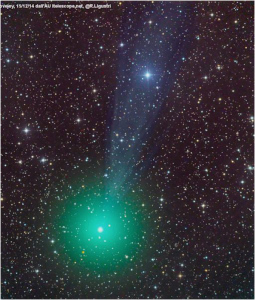Is there a cylindrical object under your Christmas tree? Open it now. A small telescope is all you need to see what’s shaping up to be a Christmas comet.

According to a number of websites dedicated to space phenomena, Comet Lovejoy (C/2014 Q2) was discovered just a few months ago by Terry Lovejoy in Australia. The green comet is brightening to naked-eye visibility as it moves into northern skies this holiday season. Italian photographer Rolando Ligustri took this picture on December 15.
“it’s amazing how this comet is developing and increasing in brightness,” Ligustri said in an article on Spaceweather.com. Indeed, it is brightening faster than experts predicted. Originally the comet was supposed to reach naked-eye visibility in January or February 2015. It may be crossing that threshold now. Reports from the southern hemisphere put the brightness of the comet at magnitude +6.0, similar to the dimmest stars the human eye can see.
On the nights around Christmas, “Comet Q2,” as some are calling it, will glide just south of Sirius, the Dog Star and by January 1 it should be visible near the constellation Orion. These finder charts from Sky and Telescope can help you find it. Better yet, if that cylindrical object is a GOTO telescope, just plug in the comet’s coordinates.
Revelstokians who want to see this celestial object should pray for clear skies.



